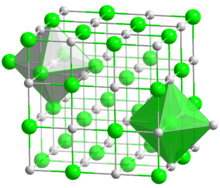Barium sulfide

| |
| Identifiers | |
|---|---|
3D model (JSmol)
|
|
| ChEBI | |
| ChemSpider | |
| ECHA InfoCard | 100.040.180 |
| EC Number |
|
| 13627 | |
PubChem CID
|
|
| UNII | |
CompTox Dashboard (EPA)
|
|
| |
| |
| Properties | |
| BaS | |
| Molar mass | 169.39 g/mol |
| Appearance | white solid |
| Density | 4.25 g/cm3 [1] |
| Melting point | 2,235[2] °C (4,055 °F; 2,508 K) |
| Boiling point | decomposes |
| 2.88 g/100 mL (0 °C) 7.68 g/100 mL (20 °C) 60.3 g/100 mL (100 °C) (reacts) | |
| Solubility | insoluble in alcohol |
Refractive index (nD)
|
2.155 |
| Structure | |
| Halite (cubic), cF8 | |
| Fm3m, No. 225 | |
| Octahedral (Ba2+); octahedral (S2−) | |
| Hazards | |
| GHS labelling: | |
 
| |
| Warning | |
| H315, H319, H335, H400 | |
| P261, P264, P271, P273, P280, P302+P352, P304+P340, P305+P351+P338, P312, P321, P332+P313, P337+P313, P362, P391, P403+P233, P405, P501 | |
| NFPA 704 (fire diamond) | |
| Lethal dose or concentration (LD, LC): | |
LD50 (median dose)
|
226 mg/kg humans |
| Related compounds | |
Other anions
|
Barium oxide |
Other cations
|
Magnesium sulfide Calcium sulfide Strontium sulfide |
Except where otherwise noted, data are given for materials in their standard state (at 25 °C [77 °F], 100 kPa).
| |
Barium sulfide is the inorganic compound with the formula BaS. BaS is the barium compound produced on the largest scale.[3] It is an important precursor to other barium compounds including BaCO3 and the pigment lithopone, ZnS/BaSO4.[4] Like other chalcogenides of the alkaline earth metals, BaS is a short wavelength emitter for electronic displays.[5] It is colorless, although like many sulfides, it is commonly obtained in impure colored forms.
Discovery
BaS was prepared by the Italian alchemist Vincentius (or Vincentinus) Casciarolus (or Casciorolus, 1571–1624) via the thermo-chemical reduction of BaSO4 (available as the mineral barite).[6] It is currently manufactured by an improved version of Casciarolus's process using coke in place of flour and charcoal. This kind of conversion is called a carbothermic reaction:
- BaSO4 + 2 C → BaS + 2 CO2
and also:
- BaSO4 + 4 C → BaS + 4 CO
The basic method remains in use today. BaS dissolves in water. These aqueous solutions, when treated with sodium carbonate or carbon dioxide, give a white solid of barium carbonate, a source material for many commercial barium compounds.[7]
According to Harvey (1957),[8] in 1603, Vincenzo Cascariolo used barite, found at the bottom of Mount Paterno near Bologna, in one of his non-fruitful attempts to produce gold. After grinding and heating the mineral with charcoal under reducing conditions, he obtained a persistent luminescent material rapidly called Lapis Boloniensis, or Bolognian stone.[9][10] The phosphorescence of the material obtained by Casciarolo made it a curiosity.[11][12][13]
Preparation
A modern procedure proceeds from barium carbonate:[14]
- BaCO3 + H2S → BaS + H2O + CO2
BaS crystallizes with the NaCl structure, featuring octahedral Ba2+ and S2− centres.
The observed melting point of barium sulfide is highly sensitive to impurities.[2]
Safety
BaS is quite poisonous, as are related sulfides, such as CaS, which evolve toxic hydrogen sulfide upon contact with water.
References
- ^ Lide, David R., ed. (2006). CRC Handbook of Chemistry and Physics (87th ed.). Boca Raton, FL: CRC Press. ISBN 0-8493-0487-3.
- ^ a b Stinn, C., Nose, K., Okabe, T. et al. Metall and Materi Trans B (2017) 48: 2922. https://doi.org/10.1007/s11663-017-1107-5 Archived 2024-01-01 at the Wayback Machine
- ^ Greenwood, Norman N.; Earnshaw, Alan (1997). Chemistry of the Elements (2nd ed.). Butterworth-Heinemann. ISBN 978-0-08-037941-8.
- ^ Holleman, A. F.; Wiberg, E. "Inorganic Chemistry" Academic Press: San Diego, 2001. ISBN 0-12-352651-5.
- ^ Vij, D. R.; Singh, N. (1992). Optical and electrical properties of II-VI wide gap semiconducting barium sulfide. Conf. Phys. Technol. Semicond. Devices Integr. Circuits, 1992. Proceedings of SPIE. Vol. 1523. pp. 608–612. Bibcode:1992SPIE.1523..608V. doi:10.1117/12.634082.
- ^ F. Licetus, Litheosphorus, sive de lapide Bononiensi lucem in se conceptam ab ambiente claro mox in tenebris mire conservante, Utini, ex typ. N. Schiratti, 1640. See http://www.chem.leeds.ac.uk/delights/texts/Demonstration_21.htm Archived 2011-08-13 at the Wayback Machine
- ^ Kresse, Robert; Baudis, Ulrich; Jäger, Paul; Riechers, H. Hermann; Wagner, Heinz; Winkler, Jochen; Wolf, Hans Uwe (2007). "Barium and Barium Compounds". Ullmann's Encyclopedia of Industrial Chemistry. Weinheim: Wiley-VCH. doi:10.1002/14356007.a03_325.pub2. ISBN 978-3527306732.
- ^ Harvey E. Newton (1957). A History of Luminescence: From the Earliest Times until 1900. Memoirs of the American Physical Society, Philadelphia, J. H. FURST Company, Baltimore, Maryland (USA), Vol. 44, Chapter 1, pp. 11-43.
- ^ Smet, Philippe F.; Moreels, Iwan; Hens, Zeger; Poelman, Dirk (2010). "Luminescence in Sulfides: A Rich History and a Bright Future". Materials. 3 (4): 2834–2883. Bibcode:2010Mate....3.2834S. doi:10.3390/ma3042834. ISSN 1996-1944.
- ^ Hardev Singh Virk (2014). "History of Luminescence from Ancient to Modern Times". ResearchGate. Retrieved 6 March 2021.
- ^ "Lapis Boloniensis". www.zeno.org. Archived from the original on 2012-10-23. Retrieved 2011-01-03.
- ^ Lemery, Nicolas (1714). Trait℗e universel des drogues simples.
- ^ Ozanam, Jacques; Montucla, Jean Etienne; Hutton, Charles (1814). Recreations in mathematics and natural philosophy .
- ^ P. Ehrlich (1963). "Alkaline Earth Metals". In G. Brauer (ed.). Handbook of Preparative Inorganic Chemistry, 2nd Ed. Vol. 2pages=937. NY, NY: Academic Press.

